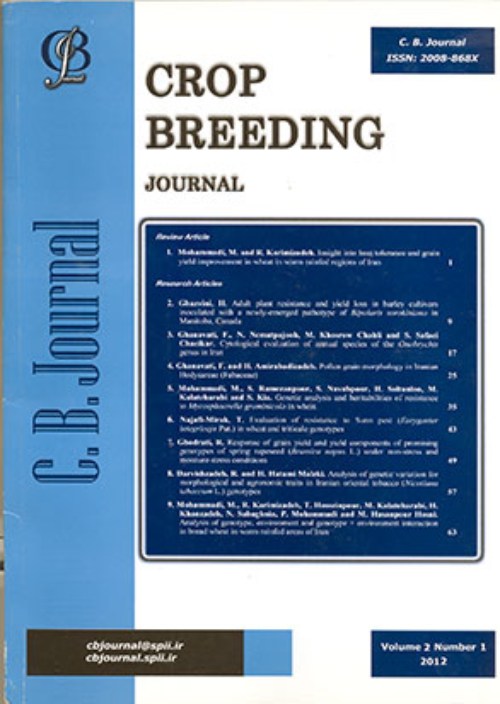Assessment of yield stability of spring bread wheat genotypes in multi-environment trials under rainfed conditions of Iran using the AMMI model
Author(s):
Abstract:
Selecting bread wheat (Triticum aestivum L.) genotypes with wide adaptation across various test environments is important for enhancing the adoption rate of newly released wheat cultivars for rainfed spring wheat growing areas of Iran. This study analyzed the grain yield of 18 bread wheat genotypes at four dryland locations in Iran during the 2010-11, 2011-12, and 2012-2013 cropping cycles using the AMMI (additive main effects and multiplicative interaction) model. The biplot of AMMI-1 and AMMI-2 models facilitated the visual evaluation and identification of suitable genotypes, which is useful for genotype recommendation and mega-environment determination. Combined analysis of variance (ANOVA) revealed significant genotype × environment interaction for bread wheat yield. According to the AMMI-2 biplot, there were six best genotypes and five best mega-environments. The AMMI-1 model indicated that genotypes G2, G5, G9, G13, G14, G16, and G17 were superior, with moderate yield and yield stability, based on the lowest genotype × environment interactions. Genotypes G1 and G15 performed successfully in Khorramabad and Gonbad (two distinct mega-environments), respectively. The AMMI model was a useful tool for identifying yield stability of spring bread wheat genotypes for rainfed spring wheat growing areas of Iran. The significant genotype × environment interaction suggested that breeding strategies for specific adaption genotypes in homogeneously grouped environments should be considered in the national rainfed spring bread wheat breeding program in Iran.
Keywords:
adaptability , biplot , drought , dryland , grain yield
Language:
English
Published:
Crop Breeding Journal, Volume:6 Issue: 2, Summer-Autumn 2016
Pages:
59 to 66
https://magiran.com/p1615771
سامانه نویسندگان
از نویسنده(گان) این مقاله دعوت میکنیم در سایت ثبتنام کرده و این مقاله را به فهرست مقالات رزومه خود پیوست کنند.
راهنما
مقالات دیگری از این نویسنده (گان)
-
Evaluation of the efficiency of WAASB, WAASBY indices and and linear mixed effects model (LMM) for identifying high- yielding lentil genotypes adapted to rainfed regions
Payam Pezeshkpour *, , Borzo Rostami
Journal of Crop Science Research in Arid Regions, -
Evaluation of the main and genotype × environment interaction effects of and estimation of correlation coefficients of genomic breeding values of bakery quality traits of bread wheat
Mohammad Reza Bihamta, , Reza Maali Amiri, Manuchehr Khodarahmi, Sachiko Isobe*
Journal of Genetics,


